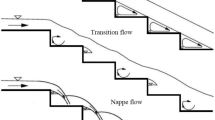Abstract
During flood discharge in a hydraulic project, rooster tails occur downstream of the piers in the spillway and have adverse effects on the operation of the discharge chute. The present paper provides an experimental study of the rooster tail generated by a pier in a chute spillway. Causes of the rooster tail were analyzed, and factors affecting the characteristics of the rooster tail were investigated. The results indicate that rooster tail height is significantly influenced by several parameters, including the spillway slope ratio, pier width and type, and outlet section water depth. A new formula was developed for estimating rooster tail height, and all the experimental data fit well in the selected experimental range. Moreover, a composite sloping-tail pier was designed based on the generation mechanism of the rooster tail. This pier can effectively eliminate rooster tail and has simple construction and lower costs.
Similar content being viewed by others
References
Maki, K.J.; Doctors, L.J.; Beck, R.F.; et al.: Transom-stern flow for high-speed craft. Aust. J. Mech. Eng. 3(2), 191–199 (2006)
Doctors, L.J.: A numerical study of the resistance of transom-stern monohulls. Ship Technol. Res. 54(3), 134–144 (2006)
Ghadimi, P.; Dashtimanesh, A.; Zamanian, R.; et al.: Rooster tail depression by originating a modified transom stern form using a Reynolds averaged Navier Stokes solver. Sci. Iran. Trans. B Mech. Eng. 22(3), 765–777 (2015)
Wu, J.H.; Cai, C.G.; Ji, W.; et al.: Experimental study on cavitation and water-wing for middle-piers of discharge tunnels. J. Hydrodyn. Ser. B 17(4), 429–437 (2005)
Chen, S.; Zhang, J.; Hu, M.; et al.: Experimental study on water-wing characteristics induced by piers in flood drainage culverts. Sci. Iran. Trans. A Civ. Eng. 20(5), 1320–1326 (2013)
Liu, S.H.; Sun, X.F.; Luo, J.: Unified model for splash droplets and suspended mist of atomized flow. J. Hydrodyn. Ser. B 20(1), 125–130 (2008)
Lian, J.J.; Li, C.; Liu, F.; et al.: A prediction method of flood discharge atomization for high dams. J. Hydraul. Res. 52(2), 274–282 (2014)
Rajaratnam, N.: Skimming flow in stepped spillways. J. Hydraul. Eng. ASCE 116(4), 587–591 (1990)
Chanson, H.: Prediction of the transition nappe skimming flow on a stepped channel. J. Hydraul. Res. 34(3), 421–429 (1996)
Toombes, L.; Wagner, C.; Chanson, H.: Flow patterns in nappe flow regime down low gradient stepped chutes. J. Hydraul. Res. 46(1), 4–14 (2008)
Carnacina, I.; Kurdistani, S.M.; Palermo, M.; et al.: El Chaparral dam Model: Rooster Tail Formation on High Sloped Spillway, pp. 65–73. School of Civil Engineering, Brisbane (2010)
Tuna, M.C.; Emiroglu, M.E.: Effect of step geometry on local scour downstream of stepped chutes. Arab. J. Sci. Eng. 38(3), 579–588 (2013)
Najafi, M.R.; Zarrati, A.R.: Numerical simulation of air-water flow in gated tunnels. Water Manag. 163(6), 289–295 (2010)
Pagliara, S.; Kurdistani, S.M.; Roshni, T.: Rooster tail wave hydraulics of chutes. J. Hydraul. Eng. ASCE 137(9), 1085–1088 (2011)
Wu, J.H.; Li, D.; Ma, F.; et al.: Fin characteristics of aerator devices with lateral deflectors. J. Hydrodyn. Ser. B 25(2), 258–263 (2013)
Najafi, M.R.; Kavianpour, M.R.; Roshan, U.; et al.: Controlling rooster tail development in gated tunnels. Int. J. Hydropower Dams 20(1), 60–65 (2013)
Abdolahpour, M.; Roshan, R.: Flow aeration after gate in bottom outlet tunnels. Arab. J. Sci. Eng. 39(5), 3441–3448 (2014)
Duan, W.J.: The submerged sloping-tail pier—an effective measure to eliminate the crown of jumping flow. J. Sichuan Univ. (Eng. Sci. Ed.) 1, 63–67 (1982). (in Chinese)
Reinauer, R.; Hager, W.H.: Supercritical flow behind chute piers. J. Hydraul. Eng. ASCE 120(11), 1292–1308 (1994)
Reinauer, R.; Hager, W.H.: Pier waves in sloping chutes. Int. J. Hydropower Dams 4(3), 100–103 (1997)
Wu, J.H.; Cai, C.G.; Ji, W.; et al.: Hydraulic characteristics of water-wings for the middle-pier of a discharge tunnel. J. Hydrodyn. Ser. B 18(5), 567–571 (2006)
Wu, J.H.; Yan, Z.M.: Hydraulic characteristics of bottom underlay-type pier for water-wing control. J. Hydrodyn. Ser. B 20(6), 735–740 (2008)
Rouse, H.; Bhoota, B.V.; Hsu, E.Y.: High-velocity flow in open channels: a symposium: design of channel expansion. Trans. Am. Soc. Civ. Eng. 116(1), 347–363 (1951)
Author information
Authors and Affiliations
Corresponding author
Rights and permissions
About this article
Cite this article
Xue, H., Diao, M., Ma, Q. et al. Hydraulic Characteristics and Reduction Measure for Rooster Tails Behind Spillway Piers. Arab J Sci Eng 43, 5597–5604 (2018). https://doi.org/10.1007/s13369-018-3237-8
Received:
Accepted:
Published:
Issue Date:
DOI: https://doi.org/10.1007/s13369-018-3237-8




